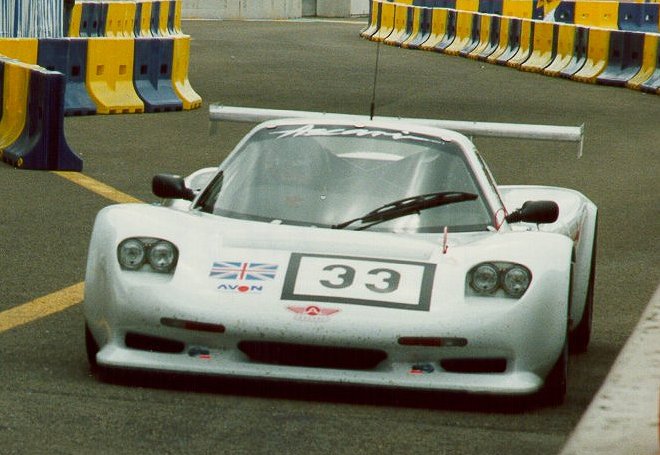The roar of a Chevrolet V8 engine pierces through the spring morning at Silverstone, 1995. A sleek, purpose-built machine cuts through the air with surgical precision, its British racing green paintwork glistening under the rare English sun. This isn’t just another race car — it’s the Ascari FGT BRDC, a remarkable fusion of road car elegance and racing pedigree.
Few vehicles embody the ambitious spirit of British motorsport quite like this rare specimen. Created by Ascari Cars, it represents a bold challenge to established manufacturers, combining cutting-edge aerodynamics with raw power in a package that could transition from circuit to street with equal composure.
Engineering Marvel: The Heart of the Beast
The FGT BRDC’s specifications read like a racing engineer’s wish list. At its core lies a thunderous 5.7-liter Chevrolet V8 engine, delivering 550 horsepower of pure American muscle through a precisely tuned British chassis. The power-to-weight ratio tells an impressive story — with just 1,050 kg to push around, each horsepower moves less than 2 kg of car.
Fact!
The Ascari FGT BRDC achieved a remarkable power-to-weight ratio that surpassed many contemporary Formula 1 cars of its era, despite being road-legal.
“The FGT BRDC represents the perfect marriage of American muscle and British precision,” notes Marcus Blackwood, vintage race car specialist at Goodwood Revival. “Its ability to handle this much power in such a lightweight frame was unprecedented for a road-legal car of its time.”
The dimensions speak to its purpose-built nature: 4,280mm of length stretched over a wide 1,820mm stance, all while keeping a low 1,120mm profile. These proportions weren’t just about aesthetics — they were carefully calculated for high-speed stability, allowing the car to reach velocities of up to 330 km/h.
Racing Heritage and Track Performance
The 1995 BRDC GT Championship became the proving ground for Ascari’s ambitious creation. With company owner Klaas Zwart behind the wheel, the FGT BRDC didn’t just participate — it competed with fierce determination against established marques.
“I witnessed the Ascari’s debut at Silverstone,” recalls James Thornton, former Autosport journalist. “The paddock was skeptical of this newcomer, but that changed the moment it took pole position. It was clear we were seeing something special.”
Key racing achievements:
- dominant victory at Silverstone GT Championship;
- impressive 5th place finish at British GT Silverstone II;
- qualification for Le Mans 24 Hours preliminary round;
- multiple top-10 finishes in the BRDC GT Championship.
Historical Reference!
The Ascari FGT BRDC's participation in the 1995 Le Mans pre-qualification marked the first time a new British manufacturer had attempted to qualify for the legendary race since Lister in 1986.
Legacy and Influence
The FGT BRDC’s influence extends far beyond its racing achievements. This pioneering vehicle laid the groundwork for Ascari’s future models, including the acclaimed Ecosse and the formidable KZ1-R. Its design philosophy — lightweight construction, aerodynamic efficiency, and road-legal race capability — became a blueprint for British sports car manufacturers.
The automotive industry quickly took notice of Ascari’s innovative approach. The FGT BRDC demonstrated that a small British company could compete with established manufacturers through clever engineering and determined execution. Its legacy lives on in the DNA of modern British supercars, where the balance of power and precision remains a guiding principle.
A Vision Realized: The Lasting Impact
In the pantheon of British racing cars, the Ascari FGT BRDC stands as a testament to ambitious engineering and racing spirit. Its story isn’t just about lap times and horsepower figures — it’s about the audacity to challenge conventions and the skill to execute that vision.
The true measure of the FGT BRDC’s significance lies in its influence on future generations of race cars. Its innovative approach to combining road and race capabilities helped shape the modern supercar landscape, where track-focused road cars have become the ultimate expression of automotive performance.
Pros and Cons
| Advantages | Disadvantages |
|---|---|
| Exceptional power-to-weight ratio: 550 hp pushing just 1,050 kg delivers remarkable performance | Limited production: Single example built makes it extremely rare and impossible for most to experience |
| Versatile design: Successfully combines road car practicality with race car performance | Challenging maintenance: Unique components and limited parts availability |
| Advanced aerodynamics: Achieves impressive high-speed stability and cornering capability | High operating costs: Race-bred components require specialist maintenance |
| Historical significance: Represents a crucial chapter in British motorsport history | Limited race success: Despite potential, achieved only one major victory |
| Innovative engineering: Pioneered several solutions adopted by later supercars | Complex servicing: Requires specialized knowledge and expertise |
The Ascari FGT BRDC 1995 stands as a remarkable achievement in automotive engineering, demonstrating that innovative design and determined execution can overcome the limitations of being a small manufacturer. While its rarity and maintenance challenges present significant drawbacks, its contribution to the evolution of British sports cars and its influence on modern supercar design principles cement its position as a significant milestone in automotive history.

